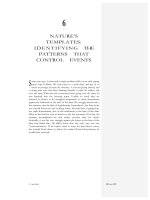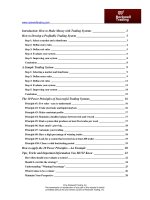7 chart patterns that consistently make money
Bạn đang xem bản rút gọn của tài liệu. Xem và tải ngay bản đầy đủ của tài liệu tại đây (5.74 MB, 71 trang )
Powerful Chart Patterns
that Consistently
Make Money
A 20-year veteran of trading, Ed Downs is the developer of the OmniTrader software, which was
released in 1994. Now in its fifth version, OmniTrader is recognized around the world as one of the
leaders in trading system automation.
Downs is also the editor of the SignalWatch daily market column, where he evaluates the overall
market, provides trading lessons, and selects charts that are exhibiting proven technical analysis
patterns. The column can be viewed at www. signalwatch.com.
Downs is also the author of the best selling book: 7 Chart Patterns That Consistently Make Money.
Nirvana Systems
(800)880-0338
E-1
Trắc nghiệm kiến thức chứng khoán Mỹ tại : www.sachchungkhoan.net
The 7 Chart Patterns that
Consistently Make Money
Ed Downs
E-2
Trắc nghiệm kiến thức chứng khoán Mỹ tại : www.sachchungkhoan.net
What is a “Pattern?”
• Patterns indicate
the psychology of
a market.
• Patterns also
determine the
behavior of a
market.
E-3
Trắc nghiệm kiến thức chứng khoán Mỹ tại : www.sachchungkhoan.net
Example: Buying at Support
Price had been here.
24 was established
by 2 touches as the
“value” point.
support
Confirmed
E-4
Trắc nghiệm kiến thức chứng khoán Mỹ tại : www.sachchungkhoan.net
Goals of Chart Pattern Analysis
1. Identify the most predictable
patterns.
2. Define rules for trading patterns
which result in winning trades.
3. We should have more winners
than losers, and the losses should
be smaller than the gains.
E-5
Trắc nghiệm kiến thức chứng khoán Mỹ tại : www.sachchungkhoan.net
Do Chart Patterns Work?
Publication:
Article:
The Economist, August 19, 2000
“Head & Shoulders, Broadening Bottoms”
Authors:
Craig MacKinlay, Wharton School and
Andrew Lo, Massachusetts Institute of Technology
“Using American share prices during 1962-96,
MacKinley and Lo focused on technical
indicators that were especially controversial
among economists such as “head and shoulders”
and “triangle tops and bottoms”.
E-6
Trắc nghiệm kiến thức chứng khoán Mỹ tại : www.sachchungkhoan.net
Yes, they do.
“The results showed that the various
technical patterns mostly occurred far more
frequently than they would have done if
they were truly random events. In general,
the charts contained useful information
about future share prices.”
E-7
Trắc nghiệm kiến thức chứng khoán Mỹ tại : www.sachchungkhoan.net
Nasdaq is better for patterns.
“(However), there was a significant difference
between the results for different markets.
For shares listed on the New York Stock
Exchange and American Stock Exchange,
seven of the ten technical patterns had enough
predictive power to be statistically significant.
For Nasdaq shares, all ten of the patterns
tested did.”
E-8
Trắc nghiệm kiến thức chứng khoán Mỹ tại : www.sachchungkhoan.net
More Art than a Science
“The traditional patterns used in technical
analysis were, of necessity, fairly crude,
determined by what was readily visible to the
eye. As a result, technical analysis has always
been more of an art than a science.”
In fact, text books on Technical Analysis
are very quick to point this out…
E-9
Trắc nghiệm kiến thức chứng khoán Mỹ tại : www.sachchungkhoan.net
More Art than Science
(continued…)
• Edwards & Magee – “An [exhaustion gap] should not be read
as a sign of Major reversal, nor even, of reversal at all. It calls
‘stop’, but the halt is ordinarily followed by some sort of area
pattern, which may lead to reversal…”
• Martin Pring – “It should not be concluded that every gap
breakout that takes place is a valid one, because there is no such
thing as a ‘sure thing’ in technical analysis.”
• William Jiler – “A [breakaway gap] generally occurs after an
important chart pattern has been completed, and it often marks
the beginning of a major move.”
Ambiguity in Chart Pattern Recognition is universal!
E-10
Trắc nghiệm kiến thức chứng khoán Mỹ tại : www.sachchungkhoan.net
We Conclude That . . .
• Chart Patterns are Predictive.
• However, identifying Chart Patterns
that “work” 100% of the time is
difficult (or impossible).
• Rules are needed to assess and trade
the opportunities.
E-11
Trắc nghiệm kiến thức chứng khoán Mỹ tại : www.sachchungkhoan.net
Chart Pattern Overview
E-12
Trắc nghiệm kiến thức chứng khoán Mỹ tại : www.sachchungkhoan.net
There are 7 Key Patterns
1.
2.
3.
4.
5.
6.
7.
Support & Resistance
Trend Line Reversal & Break
Saucer Formations
Fibonacci Retracements
Price Gaps
Volume Climax & Trend
Consolidations
Let’s discuss the Psychology of each one…
E-13
Trắc nghiệm kiến thức chứng khoán Mỹ tại : www.sachchungkhoan.net
1. Support / Resistance
“As market approaches support, and especially as
it reverses, the market participates – adding more
fuel to the fire. Support breaks can create PANIC.”
E-14
Trắc nghiệm kiến thức chứng khoán Mỹ tại : www.sachchungkhoan.net
2. Trend Lines
“An invisible line forms as price reacts to it. This
creates a similar psychology as Support and
Resistance lines do. Breaks can create panic.”
E-15
Trắc nghiệm kiến thức chứng khoán Mỹ tại : www.sachchungkhoan.net
3. Saucer Formations
“Saucers usually occur at support (resistance,
occasionally). Smooth transitions in price are
noticed, causing buyers (sellers) to enter.”
E-16
Trắc nghiệm kiến thức chứng khoán Mỹ tại : www.sachchungkhoan.net
4. Fibonacci Retracements
“Markets typically reverse on eighths, especially 3/8,
4/8, and 5/8 – which is 38%, 50%, and 62%. This is
an observed truth of market psychology.”
E-17
Trắc nghiệm kiến thức chứng khoán Mỹ tại : www.sachchungkhoan.net
5. Price Gaps
“Breakaway Gaps mark the beginnings of moves,
Measured Gaps mark the centers of moves, and
Exhaustion Gaps occur at the ends of moves.”
E-18
Trắc nghiệm kiến thức chứng khoán Mỹ tại : www.sachchungkhoan.net
6. Volume Climax, Trend
“Climaxes form powerful patterns, indicating an
exhaustion of supply or demand. If the market
does not reverse, it becomes a trend indication.”
E-19
Trắc nghiệm kiến thức chứng khoán Mỹ tại : www.sachchungkhoan.net
7. Consolidations
“Consolidations are the most powerful pattern.
Each consolidation will typically imply a move of
equal distance from the last significant low or high.”
E-20
Trắc nghiệm kiến thức chứng khoán Mỹ tại : www.sachchungkhoan.net
Rules & Tools
1) Establish a Timeframe
2) Determine a Reference
3) The Rule of Eighths
4) Avoid Volatility
5) Watch for Opposites
6) Apply Reward:Risk
E-21
Trắc nghiệm kiến thức chứng khoán Mỹ tại : www.sachchungkhoan.net
1) Establish a timeframe based on
the size of the pattern
Timeframes
are dictated by
the size and
the timeframe
of the pattern.
Timeframe A
Timeframe B
Once you
decide to trade
a timeframe,
don’t change
your mind.
Example: saucer
Small saucer
Large saucer
E-22
Trắc nghiệm kiến thức chứng khoán Mỹ tại : www.sachchungkhoan.net
2) Only trade those Patterns which have a
clear size reference in the timeframe.
?
H
B
A
At “A” we can use H.
“B” is more ambiguous.
E-23
Trắc nghiệm kiến thức chứng khoán Mỹ tại : www.sachchungkhoan.net
3) Rule of Eighths: Use eighths within the
reference to set trailing stops
62%
5/8
50% 4/8
38%
3/8
Enter Trade at 1/8
Stop at zero
E-24
Trắc nghiệm kiến thức chứng khoán Mỹ tại : www.sachchungkhoan.net
4) Avoid trading issues which reverse
across 2+ lines within 5 bars (volatile).
High Volatility
Lower Volatility
E-25
Trắc nghiệm kiến thức chứng khoán Mỹ tại : www.sachchungkhoan.net









